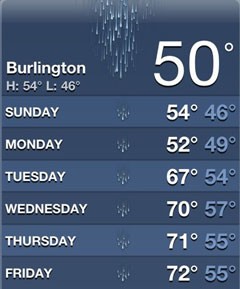
Complaining about rain in Vermont may be like complaining about the heat in Arizona, but this year Vermonters could be forgiven for thinking storm clouds have settled in for good. WCAX weatherman Gary Sadowsky reports that 12.37 inches of rain fell between May 18 and June 11, making that 25-day stretch the wettest in 130 years. And, he notes, “Four of the five wettest Mays have occurred in the 2000s.”
According to WPTZ meteorologist Tom Messner, this past May’s rainfall was five inches more than normal, and so far June has already hit three inches above the norm. “The lake level is definitely up,” Messner says, “but it’s still about one foot from flood stage. If we get too much more rain, flooding may be a concern.”
For some Vermonters, the water has swelled beyond mere “concern” to knee-deep puddles in basements and washed-out roads. And the protracted downpours have many a climate-change watcher worried about the bigger picture.
But before you start building an ark or contemplating a move to Las Vegas, listen to both local TV-weather wizards, who say this weather pattern is just sort of abnormally normal.
“As is usually the case,” Messner explains, “it is all about the upper-air patterns and where the jet stream is. This year the jet has set up such that we’re in the line of fire for rain and storms.”
Regardless of the current orientation of the jet stream, Sadowsky says Vermonters are not necessarily doomed to wear rain boots all summer. “Once you get stuck in a certain pattern, it seems to take a while before it changes,” he says. “On the other hand, there have been some very fast, total reversals in weather patterns. One day in the near future, it may just suddenly stop raining, and, before you know it, we’ll be screaming, ‘Drought!’”
Meanwhile, all this water has consequences beyond ruining your bicycle commute to work or forcing you to move your outdoor wedding inside.
Like mosquitoes.
“All the standing water is going to lead to a huge ‘herd’ of mosquitoes. They are going to be baaaaaad this summer,” predicts Sadowsky. “And also lakes, especially Champlain, get all full of junk from all the water flowing into it. And it can lead to more algae and bacteria. It also keeps the lake from warming up as fast as usual,” he adds, which is not good for recreation.
Messner’s observations aren’t encouraging, either. “I’m sure fertilizer and farm waste is washing downstream and eventually into Lake Champlain,” he says. “I’d think sump pumps pumping out basements aren’t always throwing the cleanest water into street drains.”
On the bright side, if you’re wondering what will happen to your zinnias or the vegetables in your local CSA share, they should be OK, assures gardening expert and consultant Charlie Nardozzi.
“Especially for people who have seeded vegetables or annual flowers, what they’re probably seeing, depending on the amount of standing water, are transplants looking yellow and not very vigorous,” he explains, “because there’s too much water and not enough oxygen getting to the roots.”
Nardozzi says the best thing to do is resist your impulse to add more fertilizer, wait and let things dry out. If there’s a significant amount of standing water, building a trench to draw it away from the plants isn’t a bad idea. Loosening the soil can also help get oxygen to the roots.
As for your recently planted seeds, “dig around the plant and, if you see nothing at all, then they probably rotted,” Nardozzi advises. “Just replant more seeds.”
Another issue for gardeners is that cloudy days mean less sun, which will slow down some plants’ growth. “This cool weather is great for leafy greens, lettuce, peas, spinach and kale,” Nardozzi says. “But peppers and tomatoes need warmth.”
Full Moon Farm in Hinesburg prepares for Vermont’s unpredictable weather by planting a diverse range of crops, according to co-owner David Zuckerman. “We almost always have some crops that suffer and some crops that benefit from any combination of weather,” he says.
Cooler, wetter years might threaten corn, Zuckerman says, but they can also bring bigger broccoli, better lettuces and abundant herbs. “As organic farmers, our primary weed control is dryness. So our biggest challenge [in rainy seasons] is really weed control,” he adds.
If Full Moon thrives, it’s because Zuckerman makes careful decisions about what not to plant, based on Vermont’s weather. “We don’t do strawberries anymore, because we’ve had so many wet years and high-humidity years,” Zuckerman says. “It was an economic decision.”
At River Berry Farm in Fairfax, by contrast, strawberry season will still happen. “We’re not really terribly impacted by the rain, as we have very light and sandy soils,” owner Jane Sorensen explains. “However, the cool, wet weather is delaying the strawberry picking.”
While you’re waiting for berry-picking days, resist the temptation to take out your frustrations on local meteorologists. “This is not the fault of the Channel 3 weather team — we only bring good weather!” jokes Sadowsky.
Instead, keep your umbrella handy and suck it up. What do you think keeps this place so damn green?









Comments
Showing 1-1 of 1
Comments are closed.
From 2014-2020, Seven Days allowed readers to comment on all stories posted on our website. While we've appreciated the suggestions and insights, right now Seven Days is prioritizing our core mission — producing high-quality, responsible local journalism — over moderating online debates between readers.
To criticize, correct or praise our reporting, please send us a letter to the editor or send us a tip. We’ll check it out and report the results.
Online comments may return when we have better tech tools for managing them. Thanks for reading.